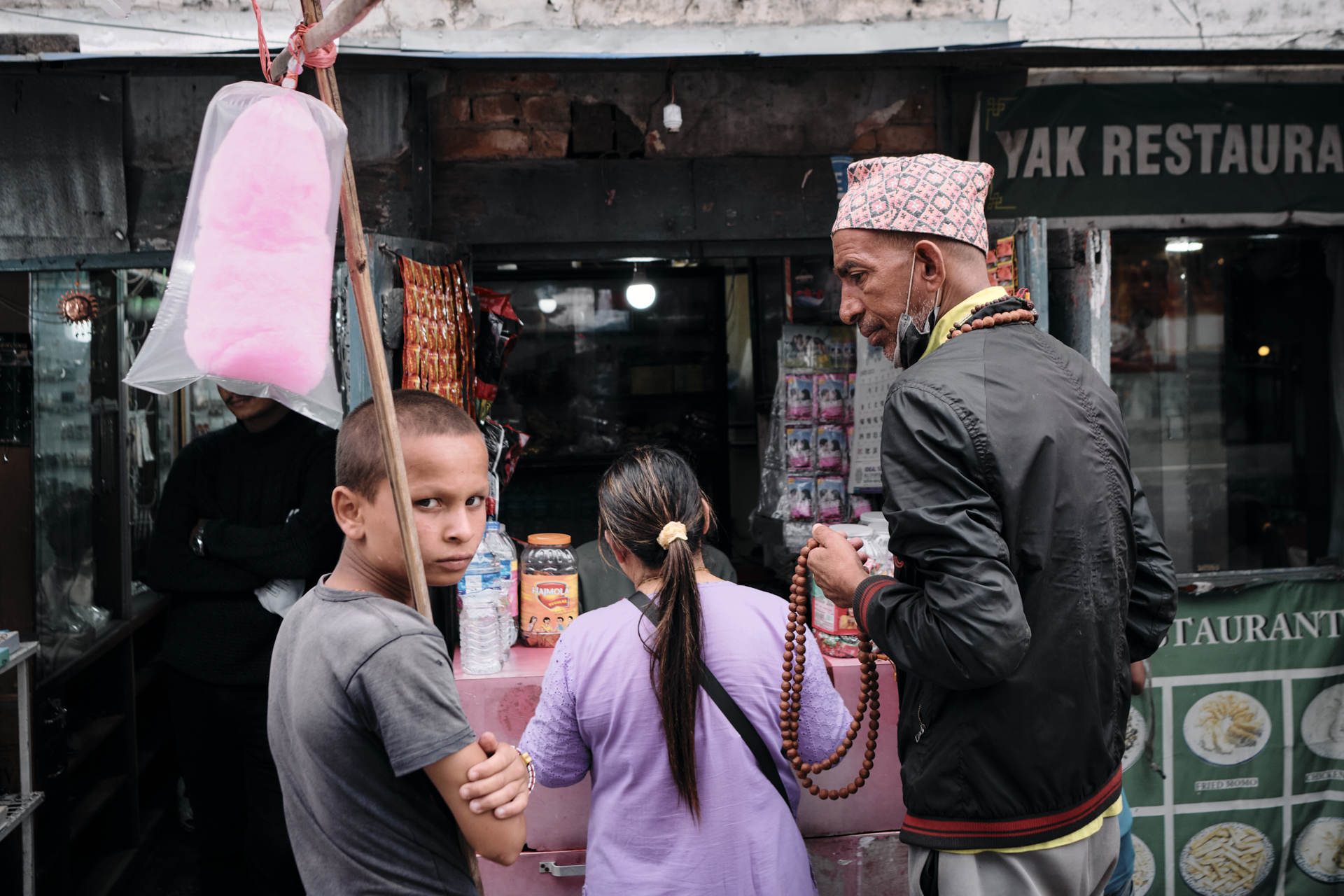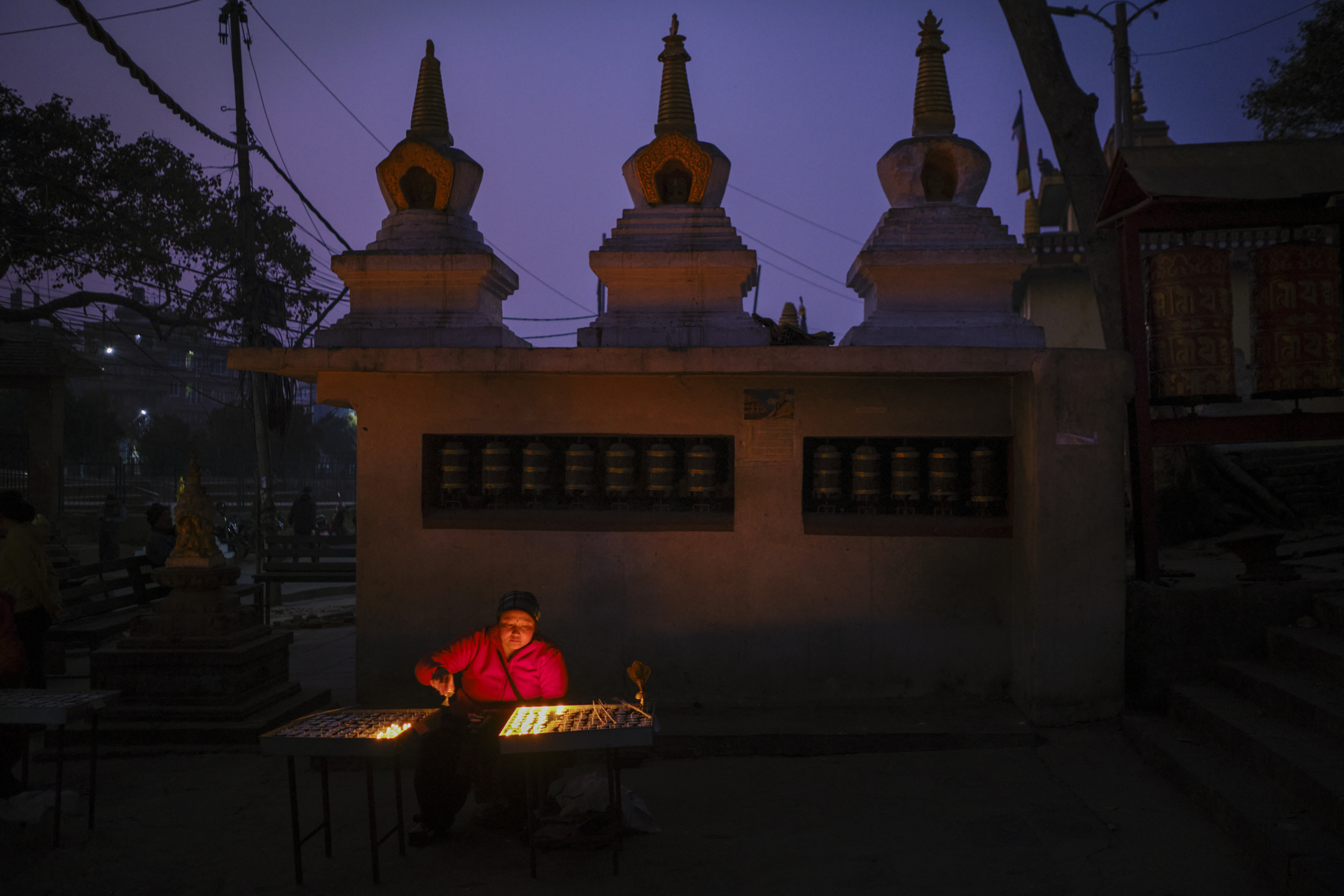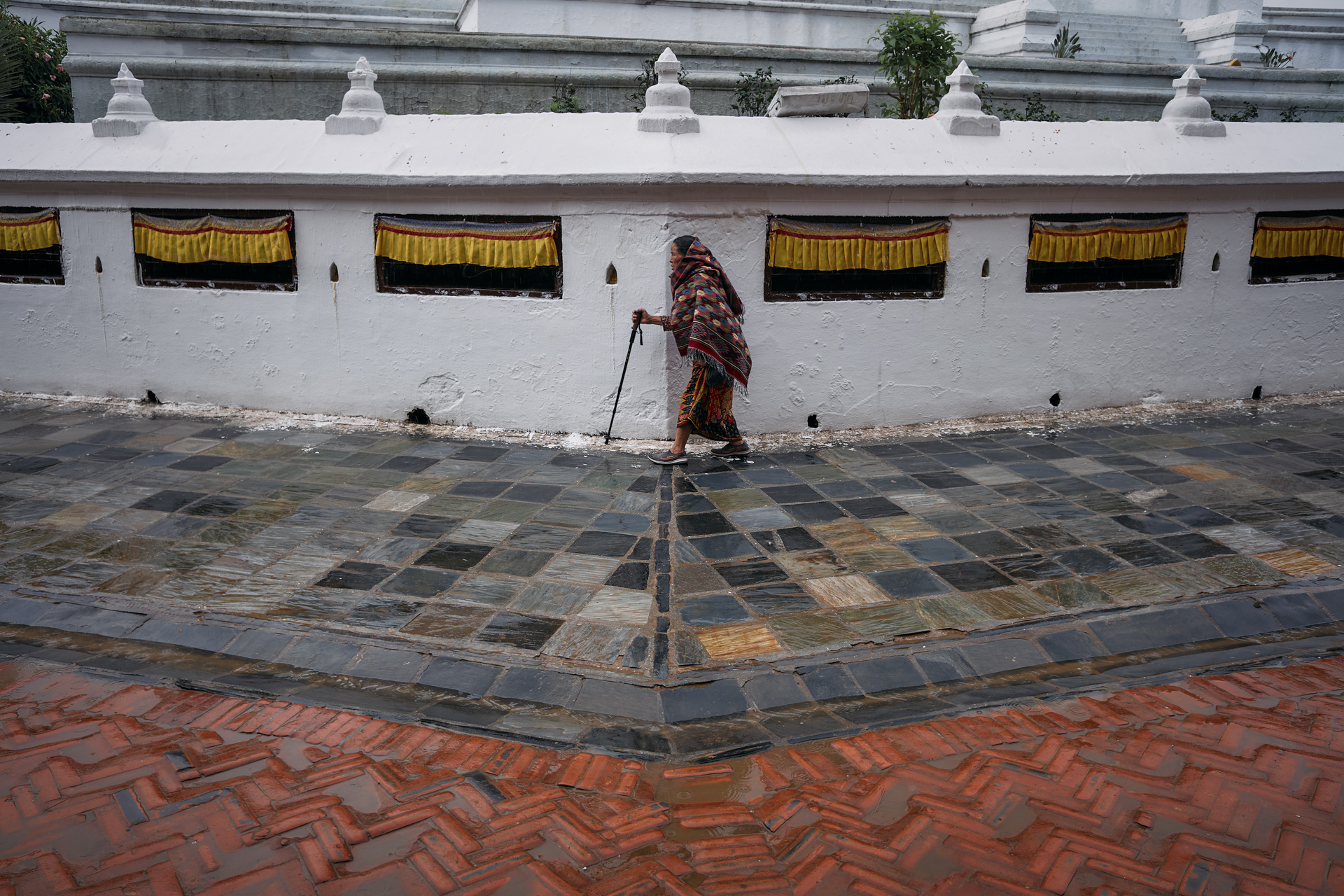
Kathmandu Street Photography Guide: Rough and Messy Beauty
Kathmandu, A Street Photography Paradise.
Kathmandu is a city of contrasts—rough, messy, and chaotic on the surface, yet filled with moments of serene beauty and deep spirituality. Little cousin of an Indian metropolis but with a rich Nepali culture of its own, Kathmandu surprises with the tranquility and willingness of its inhabitants to be photographed.
For street photographers, it’s a paradise where every corner holds a story waiting to be captured.
I hope this street photography guide will help you navigate the vibrant streets of Kathmandu, ensuring you make the most of your photographic journey.

Approaching the City
Approaching Kathmandu with an open mind is key.
The city’s initial chaos might seem overwhelming, but it’s within this seemingly disordered environment that the real magic happens. Take your time to connect with the locals, who are well-known for their warmth and kindness.
English is fairly widely spoken in Kathmandu, making communication easier for travellers.
Engage with them, show respect, and you’ll find that most are incredibly tolerant and welcoming of photographers.

However, the city’s streets can be quite dusty, and pollution levels can be high, so if you suffer from allergies or respiratory issues, it’s wise to bring a dust mask or face covering to protect yourself while exploring.

What Lenses and Gear to Bring
When it comes to gear, versatility is your best friend.
A lightweight setup is ideal for navigating the narrow, crowded streets of Kathmandu.
If you lean towards a travel-documentary style of photography, consider bringing a 24-70mm equivalent.
This lens is perfect for capturing dynamic street scenes and allows you to shoot street portraits with ease.

Otherwise, if you prefer a minimalist approach, where lightness and discretion are key, I recommend a 28 or 35mm lens.
The narrow streets of the historic center can be quite cramped, and those focal lenght allows you to include more context in your shots, making it easier to compose with layers and capture the essence of the scene

Kathmandu Street Photography Best Locations
1. The Edges of Thamel (North-West and South-East)
Thamel is the tourist hub where 90% of travelers in Nepal end up.
It has everything you need and is a convenient base for organizing the rest of your trip in Nepal.
However, try to spend as little time as possible here, as there’s very little authentic Nepali life to be found.

By moving towards the less touristy edges of Thamel, you’ll find a more authentic glimpse into everyday life in Kathmandu.
The narrow streets here are bustling with local vendors, quiet courtyards, and hidden temples.
It’s an area where you can capture both the vibrant energy and the quieter moments of local life.
Particularly interesting, is the triangle of streets between Chhetrapati, Nardevi Temples, and Asan Bazar.

2. Asan Bazar
Asan Bazar is one of the oldest and busiest marketplaces in Kathmandu.
It’s a sensory overload, with the sounds of bargaining, the smells of spices, and the vivid colours of textiles and produce.
This is an ideal spot if you enjoy creating complex and articulate images.
However, if your style leans towards clean and minimalistic compositions, you might want to skip this location.
Don’t just stick to the main streets—venture into the narrow, dimly lit alleys that often open up into hidden courtyards, temples, or charming side streets. These lesser-known paths offer unique and captivating scenes that are rich in character.

3. Annapurna Temple
Located in the heart of the city, Annapurna Temple is dedicated to the goddess of abundance.
The temple is surrounded by lively markets, offering a unique blend of religious fervor and daily commerce.
This is a location where it’s worth finding a good spot and staying for a while, allowing the scenes to unfold naturally around you. By being patient, you can capture worshippers alongside the bustling activity of the surrounding streets.

4. The Streets Between Kasthamandap and the Bishnumati River
These streets are rarely frequented by tourists, offering a raw and unfiltered view of Kathmandu.
It’s worth exploring the roads that lead down towards the river, as they have a steady flow of passersby, especially in the morning.

You can easily spend a couple of hours walking up and down these streets, soaking in the atmosphere and discovering hidden gems. The architecture here is a blend of ancient and modern, with traditional homes standing alongside newer constructions that have emerged after the 2015 earthquake.

5. Swayambhunath (The Monkey Temple)
Perched on a hilltop, Swayambhunath offers panoramic views of Kathmandu.
Being a standalone hill, the light works well both at sunrise and sunset.
The temple is one of the most sacred Buddhist sites in the city and holds a similar significance for the Newari people of Kathmandu as Boudhanath does for the Tibetans.
The temple and the surrounding forest are home to hundreds of monkeys, some of which can be quite mischievous.

There are two ways to reach the top: you can take a taxi directly to the northern entrance, or you can opt for the steep climb up 365 steps.

Along this ascent, you’ll find small stupas, shrines, chortens, and plenty of monkeys, all of which provide a rich context for photography, especially in the early morning.

Don’t remain only around the main stupa—continue your climb up to the Maha Manjushree Temple for a complete view of the area. The combination of spiritual significance, playful monkeys, dedicated pilgrims, and stunning vistas makes this a must-visit location for street photography in Kathmandu.

6. Boudhanath
Boudhanath is one of the largest stupas in the world and a UNESCO World Heritage site.
It’s a place of deep spiritual significance, with a serene atmosphere that contrasts sharply with the hustle of the surrounding streets.

This area is more than just a place to visit—it’s a neighbourhood worth considering for a few days’ stay, especially given its proximity to Pashupatinath Temple.

Boudhanath is the heart of the Tibetan exile community in Kathmandu, and this cultural richness is palpable in every corner.

However, it’s important to note that Tibetans, unlike many Nepalis, are generally not fond of being photographed, especially without permission or in an intrusive manner.
The stupa itself is encircled by a ring of buildings, cafes, and shops, where hundreds of people walk in a ritual circumambulation, known as the “kora,” throughout the day.
Photographic opportunities abound, particularly during the Puja times at dawn and dusk, when the atmosphere is charged with devotion.

The entire Boudhanath neighborhood is dotted with Tibetan monasteries, each with its own unique activities.
Some monasteries allow visitors to photograph freely, but it’s crucial to ask for permission first.
Exploring the area involves wandering through the narrow, less-traveled streets where the daily life of locals unfolds.

One side excursion to consider is the walk from Boudha to Kopan Monastery.
This one hour walk takes you through parts of the city that tourists rarely see, offering countless opportunities for street photography along the way, not to mention the breathtaking panorama once you reach the top.

7. Pashupatinath
Pashupatinath is the most important Hindu temple in Nepal, located on the banks of the Bagmati River.
The temple complex is not just a place of worship but also a site where life and death coexist, as it is a major site for cremations. The spiritual ambiance here is profound, offering photographers a chance to document rituals that are both intimate and universal.
You can easily spend an entire day here, or even several days if you are inclined towards a documentary approach.

There are four main areas within Pashupatinath that provide rich opportunities for photography :
On the Banks of the Bagmati River, below Guhyeshwari Shaktipeeth Temple: This is another area where cremation ceremonies take place. Here, Brahmins perform pujas, and devotees pray around a massive Banyan tree, offering powerful and emotional scenes.

The Upper Area around Gorakhnath Temple and the Surrounding Forest: This quieter, more secluded part of the complex provides a different perspective, with opportunities to capture the peaceful coexistence of nature and spirituality.

The Steps Where the Aarati Ceremony is Celebrated at Sunset: As the sun sets, the Aarati ceremony lights up the evening with music, fire, and devotion, creating a vibrant atmosphere that is a must-see.

Ram Ghat: This section of the river is another significant spot for rituals and offers a unique view of the temple complex from across the water.

Each of these areas offers its own unique scenes and stories, making Pashupatinath a rich environment for street and documentary photography.
The Best Times to Shoot Street Photography in Kathmandu
Throughout the day, different times offer unique opportunities.
Late morning to early afternoon is best for capturing artisans at work, while mid-morning to late afternoon is ideal for documenting daily routines like children heading to school or families preparing meals.
Aligning your photography with these daily rhythms will help you capture the authentic spirit of Kathmandu.

For spiritual and cultural life, early morning at sunrise and late afternoon at sunset are ideal.
At dawn, temples and stupas come alive with rituals, and the soft, golden light adds a mystical quality to your shots. Around 9 AM, markets like Asan Bazar buzz with activity.

Where to Stay
When choosing where to stay in Kathmandu, consider locations that align with your photography goals and the best times to shoot. Here are some recommendations based on the different areas and times of day we’ve discussed:
1. Boudhanath Area
If you’re interested in capturing the early morning and late afternoon rituals, staying near Boudhanath Stupa is ideal.
The area is quieter than Thamel and offers a serene atmosphere.
You’ll be steps away from the stupa, allowing you to easily photograph the morning prayers and evening Puja.
Plus, being close to the Tibetan community gives you access to the nearby monasteries, where you can explore and photograph throughout the day. Additionally, staying in Boudha offers the convenience of being just 2.5 km away from Pashupatinath, making it easy to reach this significant site for more photography opportunities.
2. Durbar Square Vicinity
Staying near Durbar Square provides easy access to some of the most iconic historic sites in Kathmandu.
This area is great for photographing street life with the backdrop of temples and Newari architecture.
The nearby streets offer rich opportunities for capturing the daily life of the city’s residents, with very few tourists around.
Accommodations here are a bit more limited than in Thamel, but it’s an alternative worth considering if you prefer to avoid crowds of tourists and souvenir shops.
3. Thamel Edges (North-West and South-East)
While the main area of Thamel is very touristy, staying on the edges of Thamel can give you a good balance of convenience and authenticity. You’ll be close enough to explore the vibrant street life and markets in the early morning, such as Asan Bazar, Annapurna Temple and the streets around.
At the same time, you’ll also have easy access to a wide range of accommodations for all budgets and a good variety of restaurants to suit every taste.

Conclusion
Kathmandu is a city of contrasts, where the rough and messy exterior hides a gentle soul waiting to be discovered. As a travel and street photographer, you’ll find endless opportunities to capture the city’s vibrant energy, spiritual depth, and everyday life. In my opinion, four days is the minimum to appreciate the city’s rich scenery and dynamic situations, especially if you choose to stay in two distinct areas.
I hope this photography guide to Kathmandu not only helps you make the most of your stay but also inspires you to capture the images that resonate deeply with your creative vision and leave you with lasting memories of this Photographer’s Paradise.
“Feeling inspired by Kathmandu’s vibrant chaos and ready to explore more? Consider joining my dedicated Nepal Photo Tour for a photographic journey through the heart and soul of this fascinating city.”
If you have any questions about Nepal, Kathmandu, or my upcoming Photo Tours and Workshops, feel free to send me a message! I’m always happy to share advice and inspiration.
Best,
Lorenz Berna




